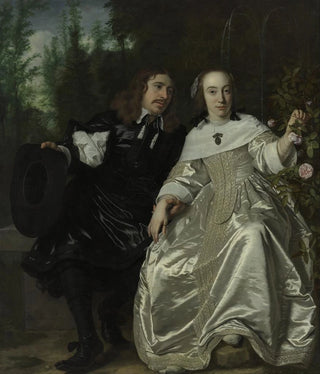Painting Abraham del Court and his wife Maria de Kaersgieter - Bartholomeus van der Helst | Art print


View from behind

Frame (optional)
In the world of art, certain works transcend their era to become timeless witnesses to the human condition. The art print of Abraham del Court and his wife Maria de Kaersgieter by Bartholomeus van der Helst is one of these iconic pieces. This painting, capturing a moment of intimacy and dignity, immerses us in the bourgeois universe of 17th-century Dutch society, where the depiction of human figures is both an act of memory and a reflection of social values. Through this work, Van der Helst offers us a penetrating vision of daily life, while highlighting the beauty and complexity of human relationships.
Style and uniqueness of the work
Bartholomeus van der Helst's style is characterized by an impressive mastery of portraiture, where light and shadow intertwine to create a strikingly realistic atmosphere. In this art print, the meticulous details of clothing, the texture of fabrics, and the expressions on faces testify to exceptional craftsmanship. The colors, both rich and harmonious, enhance the depth of the characters, while the carefully orchestrated composition guides the viewer’s gaze across the painting. Every element, from the background to accessories, is chosen with care to enrich the visual storytelling, transforming the portrait into a lively scene where one can almost hear the whispers of an intimate conversation.
The artist and his influence
Bartholomeus van der Helst, a Dutch painter of the 17th century, is often recognized for his contribution to the genre of portraiture. Raised in a flourishing artistic context, he established himself as one of the masters of his time, attracting the attention of wealthy patrons and the bourgeoisie of Amsterdam. His influence extends beyond his era, as his painting techniques and approach to portraiture have inspired many later artists. By emphasizing the psychology of the characters and capturing their essence, Van der Helst paved the way for a new form of artistic expression, where the portrait becomes a means of storytelling and exploring social dynamics. His ability to immortalize his subjects with such humanity and emotional depth continues

Matte finish

View from behind

Frame (optional)
In the world of art, certain works transcend their era to become timeless witnesses to the human condition. The art print of Abraham del Court and his wife Maria de Kaersgieter by Bartholomeus van der Helst is one of these iconic pieces. This painting, capturing a moment of intimacy and dignity, immerses us in the bourgeois universe of 17th-century Dutch society, where the depiction of human figures is both an act of memory and a reflection of social values. Through this work, Van der Helst offers us a penetrating vision of daily life, while highlighting the beauty and complexity of human relationships.
Style and uniqueness of the work
Bartholomeus van der Helst's style is characterized by an impressive mastery of portraiture, where light and shadow intertwine to create a strikingly realistic atmosphere. In this art print, the meticulous details of clothing, the texture of fabrics, and the expressions on faces testify to exceptional craftsmanship. The colors, both rich and harmonious, enhance the depth of the characters, while the carefully orchestrated composition guides the viewer’s gaze across the painting. Every element, from the background to accessories, is chosen with care to enrich the visual storytelling, transforming the portrait into a lively scene where one can almost hear the whispers of an intimate conversation.
The artist and his influence
Bartholomeus van der Helst, a Dutch painter of the 17th century, is often recognized for his contribution to the genre of portraiture. Raised in a flourishing artistic context, he established himself as one of the masters of his time, attracting the attention of wealthy patrons and the bourgeoisie of Amsterdam. His influence extends beyond his era, as his painting techniques and approach to portraiture have inspired many later artists. By emphasizing the psychology of the characters and capturing their essence, Van der Helst paved the way for a new form of artistic expression, where the portrait becomes a means of storytelling and exploring social dynamics. His ability to immortalize his subjects with such humanity and emotional depth continues
12,34 €






